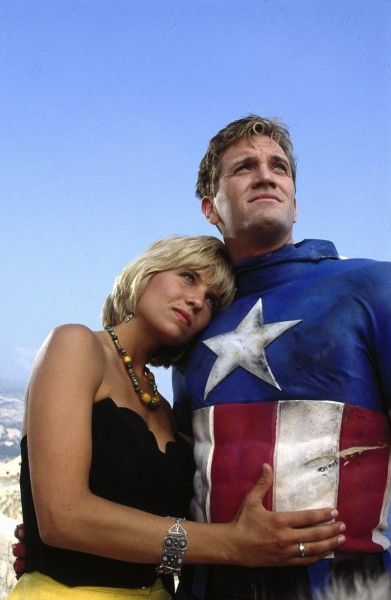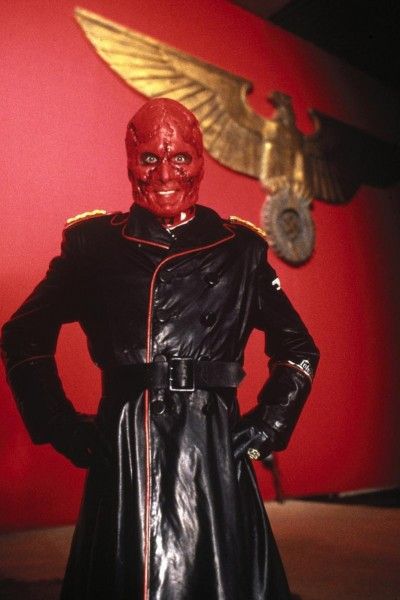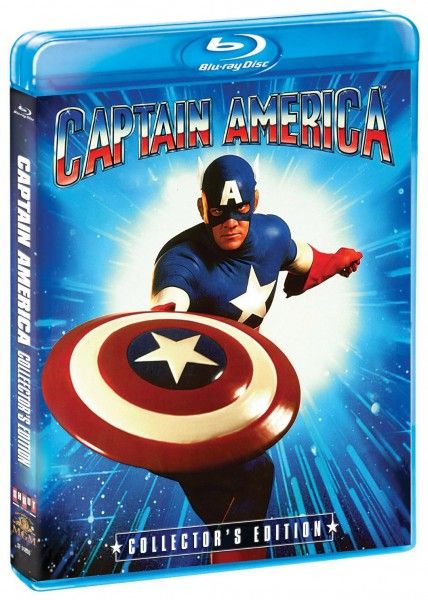Hero Steve Rogers, a.k.a Captain America, can use his peak human powers to battle the forces of evil, but even he is no match for plot holes, budget constraints, and downright silly story choices. The 1990 Captain America film directed by Albert Pyun, the first live action film starring Marvel Comic’s iconic patriotic superhero, is a textbook example of what happens when a crew gives their all to a production that was doomed with an almost non-existent budget and tight filming schedule. Hit the jump for my Blu-ray review of Captain America.
The story follows the exploits of sickly Steve Rogers (Matt Salinger), an all-American man who gives himself over to his country in order to battle the forces of Hitler in World War 2. He is the single candidate out of 600 that was deemed ideal to undergo the government’s secret Super Soldier program, developed to fill America’s armed forces with soldiers that exhibited strength, speed, and intelligence to rival even the best of world athletes. Unfortunately, Steve is the first and last soldier the program creates, as the sole scientist with knowledge of the process is slain by a German agent. Named Captain America by his superiors, he embarks on a mission to stop a sinister villain known as The Red Skull (Scott Paulin), who plans to launch a missile at some unknown American city. Steve unsuccessfully battles The Red Skull, and winds up frozen for 47 years, and awakens in 1990 to find a changed world where his nemesis is still on the loose.
Given that the movie is based on a super hero comic, one can assume the story takes a few liberties with reality, but this film outright begs audiences to not think too hard about the plot and just “go along with it”. First, the pacing is so fast paced one would think the writers crammed two movies into one feature length film. The origin story of Steve Rogers flashes by in less than 30 minutes, which is rather a shame, since so much of the character is derived from the events in the 1940s. For example, the story never touches on why Captain America carries a shield, it simply relies on viewers knowing the character carries one to be explanation enough. These little details can sound nitpicky, but giving audiences a solid foundation helps make the character seem real and relatable instead of a campy do gooder who battles bad guys for the heck of it.
The film’s biggest issue is its often silly plot mechanics and gaping holes. The victorious Red Skull straps Steve to the missile he is launching at the nation’s capital, who then manages to divert its trajectory, saving the president and thwarting the Skull’s plans. Hooray, except Steve winds up frozen “somewhere in Alaska”…in a snow bank. Not arctic waters or something more believable, a simple snow bank, one that men wearing barely zipped jackets can discover him in. Now that the Captain is out of the way, the Skull can do as he wills and bring the entire world to its knees. Except he doesn’t. With no force capable of opposing him in his way, he just seems to drop his plans for domination and fade into obscurity, becoming a billionaire assassin with a family. It would seem hostile takeover just wasn’t the same after the first missile failed. To go on would spoil the movie, but needless to say, these sort of glaring issues surface again, and again, and again.
Interestingly enough, acting isn’t one of the film’s major issues. While one can argue that the script’s treatment of Steve Rogers does a disservice to the character (where comic Steve is a confident soldier who loves the red, white, and blue, movie Steve is a scared lab rat unsure of himself or rising to the challenge), Matt Salinger’s performance gives the film exactly what it called for. He constantly battles with self-doubt, and exudes a reluctance backed by a need to right the wrong of his past failures. Though slightly over the top, Scott Paulin gives The Red Skull an air of superiority and suave insanity that befits a powerful villain. The best performance, however, is found in Ned Beatty’s portrayal of journalist Sam Kolawetz. Though only on screen for brief moments, his enthusiasm for the character gives audiences a truly entertaining experience, all while while bringing together the two seemingly disjointed stories in a somewhat believable way. The film could have used much more of him.
Though terribly short on extras (the collector’s edition release doesn’t even have a chapter select menu), the Blu-Ray does contain a featurette with interviews with both Albert Pyun and Matt Salinger, which actually explains why the film turned out the way it did. It’s in the interviews that audiences learn that the film’s budget was sickeningly small, to the point that a large portion of the action scenes had to be scraped; not a good sign when making a super hero action flick. The two also mention that the filming schedule had to be condensed to meet an extremely tight deadline, further adding to its list of woes. If one is going to put themselves through the comical 97-minute film, they might as well take another 20 some odd minutes to learn why and how it was so, so bad.
If taken on its own merits—a small budget super hero movie made under severe constraints in a time of big hair and cheesy music—viewers can have an enjoyable time watching Captain America, though it’ll be at the film’s expense. If nothing else, it gives one a look at how far comic book movies have come over the past 20 years, both in production value and seriousness.
Movie: D+, Disc: C-




